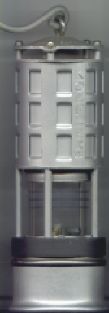
Blackdamp
Encyclopedia
Blackdamp is an asphyxiant
, reducing the available oxygen
content of air to a level incapable of sustaining human or animal life. It is not a single gas but a mixture of unbreathable gasses left after oxygen is removed from the air and typically consists of nitrogen
, argon
, carbon dioxide
and water vapour. The suffix damp is believed to derive from the German word for vapours ("Dampf"). The word damp is used in similar mining terms such as white damp (carbon monoxide
), fire damp
(typically methane
) and stink damp (hydrogen sulfide
).
(especially in a historical context), due to its omnipresence where exposed coal is found, and slow onset of symptoms. It produces no obvious odor (unlike stinkdamp), is constantly being reintroduced to the air (instead of being released in pockets from actively mined sections), and does not require combustion
in order to be released (unlike whitedamp
or afterdamp
). Many of the initial symptoms of oxygen deprivation (dizziness, light-headedness, drowsiness and poor coordination) are relatively innocuous and can easily be mistaken for simple fatigue, a far from unlikely diagnosis in the physically strenuous job of coal mining. The time between the onset of initial symptoms and the start of frank asphyxia
tion (and rapid unconsciousness) can be as short as seconds. Thus, if the warning signs are missed, a large number of miners can be rapidly incapacitated in the same short period of time, leaving no one to summon help.
In addition to the danger inside the mine, blackdamp can be "exhaled" in large quantities from mines (especially long-abandoned coal mines with few outlets for escaping gas) during sudden changes in atmospheric pressure, potentially causing asphyxiation on the surface.

 The gas mixture has been responsible for many deaths among underground workers, especially miners. For example, the Hartley Colliery Disaster
The gas mixture has been responsible for many deaths among underground workers, especially miners. For example, the Hartley Colliery Disaster
when the entire population of a colliery in north-east England were trapped when the beam of an engine suddenly broke and fell down the single shaft, blocking it with debris. It entombed 204 men and boys, who could not be rescued, and so suffocated in the blackdamp atmosphere, and died.
or hand-held electronic gas detectors. The safety lamp is merely a specially designed lantern with a flame that is designed to automatically extinguish itself at an oxygen concentration of approximately 18% (normal atmospheric concentration of oxygen is ~21%). This low detection threshold gives miners an unmistakable warning and allows them to escape before any potentially incapacitating effects are felt. Traditionally using a caged canary was an effective biological way to detect blackdamp because a canary would succumb to dangerous air conditions faster than humans.
Asphyxiant gas
An asphyxiant gas is a non-toxic or minimally toxic gas which reduces or diplaces the normal oxygen concentration in breathing air. Prolonged breathing of oxygen depleted air can lead to death by asphyxiation...
, reducing the available oxygen
Oxygen
Oxygen is the element with atomic number 8 and represented by the symbol O. Its name derives from the Greek roots ὀξύς and -γενής , because at the time of naming, it was mistakenly thought that all acids required oxygen in their composition...
content of air to a level incapable of sustaining human or animal life. It is not a single gas but a mixture of unbreathable gasses left after oxygen is removed from the air and typically consists of nitrogen
Nitrogen
Nitrogen is a chemical element that has the symbol N, atomic number of 7 and atomic mass 14.00674 u. Elemental nitrogen is a colorless, odorless, tasteless, and mostly inert diatomic gas at standard conditions, constituting 78.08% by volume of Earth's atmosphere...
, argon
Argon
Argon is a chemical element represented by the symbol Ar. Argon has atomic number 18 and is the third element in group 18 of the periodic table . Argon is the third most common gas in the Earth's atmosphere, at 0.93%, making it more common than carbon dioxide...
, carbon dioxide
Carbon dioxide
Carbon dioxide is a naturally occurring chemical compound composed of two oxygen atoms covalently bonded to a single carbon atom...
and water vapour. The suffix damp is believed to derive from the German word for vapours ("Dampf"). The word damp is used in similar mining terms such as white damp (carbon monoxide
Carbon monoxide
Carbon monoxide , also called carbonous oxide, is a colorless, odorless, and tasteless gas that is slightly lighter than air. It is highly toxic to humans and animals in higher quantities, although it is also produced in normal animal metabolism in low quantities, and is thought to have some normal...
), fire damp
Firedamp
Firedamp is a flammable gas found in coal mines. It is the name given to a number of flammable gases, especially methane. It is particularly commonly found in areas where the coal is bituminous...
(typically methane
Methane
Methane is a chemical compound with the chemical formula . It is the simplest alkane, the principal component of natural gas, and probably the most abundant organic compound on earth. The relative abundance of methane makes it an attractive fuel...
) and stink damp (hydrogen sulfide
Hydrogen sulfide
Hydrogen sulfide is the chemical compound with the formula . It is a colorless, very poisonous, flammable gas with the characteristic foul odor of expired eggs perceptible at concentrations as low as 0.00047 parts per million...
).
Sources
Blackdamp is encountered in enclosed environments such as mines, sewers, wells, tunnels and ships' holds. It occurs with particular frequency in abandoned or poorly ventilated coal mines. Coal, once exposed to the air of a mine, naturally begins absorbing oxygen and exuding carbon dioxide and water vapor. The amount of blackdamp exuded by a mine varies based on a number of factors, including the time of year (coal releases more carbon dioxide in the summer months), the amount of exposed coal, and the type of coal, although all mines with exposed coal produce gas.Hazards
Blackdamp is considered a particularly pernicious type of dampDamp (mining)
Historically, gases in coal mines in Britain were collectively known as "damps". This comes from the Middle Low German word dampf , and was in use by 1480 .Damps included:...
(especially in a historical context), due to its omnipresence where exposed coal is found, and slow onset of symptoms. It produces no obvious odor (unlike stinkdamp), is constantly being reintroduced to the air (instead of being released in pockets from actively mined sections), and does not require combustion
Combustion
Combustion or burning is the sequence of exothermic chemical reactions between a fuel and an oxidant accompanied by the production of heat and conversion of chemical species. The release of heat can result in the production of light in the form of either glowing or a flame...
in order to be released (unlike whitedamp
Whitedamp
Whitedamp is a noxious mixture of gases formed by the combustion of coal, usually in an enclosed environment such as a coal mine. The most toxic constituents are carbon monoxide and hydrogen sulfide...
or afterdamp
Afterdamp
Afterdamp is the toxic mixture of gases left in a mine following an explosion caused by firedamp, which itself can initiate a much larger explosion of coal dust. It consists of carbon dioxide, carbon monoxide and nitrogen. Hydrogen sulfide, another highly toxic gas, may also be present...
). Many of the initial symptoms of oxygen deprivation (dizziness, light-headedness, drowsiness and poor coordination) are relatively innocuous and can easily be mistaken for simple fatigue, a far from unlikely diagnosis in the physically strenuous job of coal mining. The time between the onset of initial symptoms and the start of frank asphyxia
Asphyxia
Asphyxia or asphyxiation is a condition of severely deficient supply of oxygen to the body that arises from being unable to breathe normally. An example of asphyxia is choking. Asphyxia causes generalized hypoxia, which primarily affects the tissues and organs...
tion (and rapid unconsciousness) can be as short as seconds. Thus, if the warning signs are missed, a large number of miners can be rapidly incapacitated in the same short period of time, leaving no one to summon help.
In addition to the danger inside the mine, blackdamp can be "exhaled" in large quantities from mines (especially long-abandoned coal mines with few outlets for escaping gas) during sudden changes in atmospheric pressure, potentially causing asphyxiation on the surface.
Disasters


Hartley Colliery Disaster
The Hartley Colliery Disaster was a disastrous mining accident in Northumberland, England in 1862 in which 220 lives were lost. - Cause :In an age when methane or coal dust and firedamp explosions were common, the tragedy at Hartley Colliery, Northumberland, England was different because it was...
when the entire population of a colliery in north-east England were trapped when the beam of an engine suddenly broke and fell down the single shaft, blocking it with debris. It entombed 204 men and boys, who could not be rescued, and so suffocated in the blackdamp atmosphere, and died.
Detection and countermeasures
In active mining operations, the threat from blackdamp is addressed with proper mineshaft ventilation as well as various detection methods, typically using miner's safety lampsSafety lamp
A safety lamp is any of several types of lamp, which are designed to be safe to use in coal mines. These lamps are designed to operate in air that may contain coal dust, methane, or firedamp, all of which are potentially flammable or explosive...
or hand-held electronic gas detectors. The safety lamp is merely a specially designed lantern with a flame that is designed to automatically extinguish itself at an oxygen concentration of approximately 18% (normal atmospheric concentration of oxygen is ~21%). This low detection threshold gives miners an unmistakable warning and allows them to escape before any potentially incapacitating effects are felt. Traditionally using a caged canary was an effective biological way to detect blackdamp because a canary would succumb to dangerous air conditions faster than humans.

